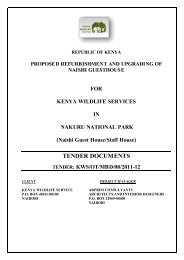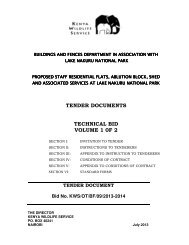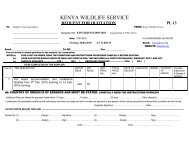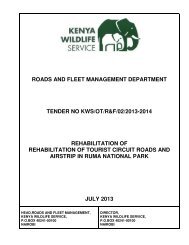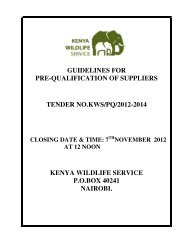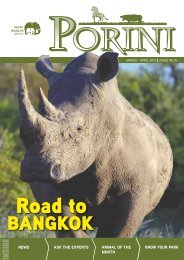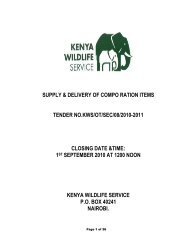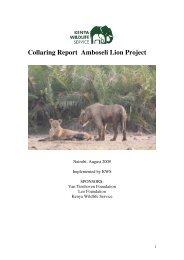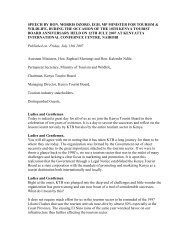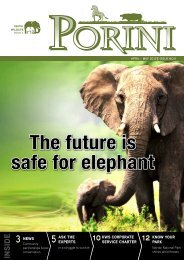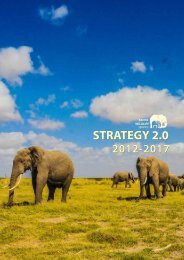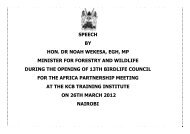Conservation and Management Strategy for the Elephant in Kenya
Conservation and Management Strategy for the Elephant in Kenya
Conservation and Management Strategy for the Elephant in Kenya
Create successful ePaper yourself
Turn your PDF publications into a flip-book with our unique Google optimized e-Paper software.
CONSERVATION AND MANAGEMENT STRATEGY FOR THE ELEPHANT IN KENYA 3<br />
1.1.1 <strong>Elephant</strong> numbers, mortality <strong>and</strong> threats<br />
Estimates of elephant numbers are used to compare population status <strong>in</strong> different parts of elephant range with<strong>in</strong><br />
countries, regions <strong>and</strong> across <strong>the</strong> cont<strong>in</strong>ent. Estimates are also used to evaluate trends of population growth or<br />
decl<strong>in</strong>e. A variety of methods, from aerial total counts to rough guesses, have been used to obta<strong>in</strong> population<br />
estimates, produc<strong>in</strong>g results with vary<strong>in</strong>g degrees of accuracy <strong>and</strong> precision. It should be noted that comparisons<br />
between sites <strong>and</strong> through time are truly valid only when us<strong>in</strong>g data that have been collected us<strong>in</strong>g <strong>the</strong> same<br />
methodologies. Produc<strong>in</strong>g regional or national totals by add<strong>in</strong>g up estimates of different quality could be justified to<br />
give a general total, but should not be relied upon <strong>for</strong> accurate descriptions of elephant status.<br />
Estimat<strong>in</strong>g numbers <strong>and</strong> distribution of elephant populations <strong>in</strong> savannah habitat is relatively straight<strong>for</strong>ward, s<strong>in</strong>ce<br />
visibility <strong>in</strong> <strong>the</strong> open vegetation allows direct count<strong>in</strong>g us<strong>in</strong>g st<strong>and</strong>ard techniques common across Africa, such as<br />
aerial total or sample counts <strong>and</strong> ground counts or <strong>in</strong>dividual recognition studies. <strong>Elephant</strong> populations <strong>in</strong> thick<br />
bushl<strong>and</strong> or <strong>for</strong>est, by contrast, must be estimated by <strong>in</strong>direct methods, primarily <strong>in</strong>volv<strong>in</strong>g dung surveys. These<br />
methods when properly designed <strong>and</strong> undertaken can produce figures that are as precise as direct counts (Barnes,<br />
2001; Hedges & Lawson, 2006). In some cases, <strong>the</strong> only available estimate <strong>for</strong> a remote population is an ‘<strong>in</strong><strong>for</strong>med<br />
guess’. As noted above, it would be mislead<strong>in</strong>g to estimate a s<strong>in</strong>gle set of figures <strong>for</strong> <strong>the</strong> size or trend of <strong>Kenya</strong>’s<br />
national elephant meta-population by simple addition of estimates of all <strong>the</strong> <strong>in</strong>dividual populations. Trend data,<br />
based on repeated estimates us<strong>in</strong>g <strong>the</strong> same methodology, are available <strong>for</strong> some key populations <strong>and</strong> can be used<br />
to contribute to an overall picture of <strong>the</strong> current position <strong>and</strong> future prospects of elephants <strong>in</strong> <strong>the</strong> country.<br />
There are three sources of <strong>in</strong><strong>for</strong>mation on elephant status <strong>in</strong> <strong>Kenya</strong>:<br />
1. Reports prepared by KWS (<strong>Kenya</strong> Wildlife Service) staff <strong>and</strong> consultants.<br />
2. KWS Policy Framework <strong>and</strong> Development Programme 1991-1996, o<strong>the</strong>rwise called KWS ‘Zebra Books’:<br />
Annex 7 The <strong>Conservation</strong> of <strong>Elephant</strong>s <strong>and</strong> Rh<strong>in</strong>os.<br />
3. The African <strong>Elephant</strong> Status Reports (<strong>for</strong>merly <strong>the</strong> African <strong>Elephant</strong> Database) which provided national-level<br />
summaries on a more-or-less regular basis s<strong>in</strong>ce 1995 by <strong>the</strong> African <strong>Elephant</strong> Specialist Group (AfESG) of <strong>the</strong> Species<br />
Survival Commission (SSC) of <strong>the</strong> International Union <strong>for</strong> <strong>Conservation</strong> of Nature (IUCN), us<strong>in</strong>g <strong>in</strong><strong>for</strong>mation supplied<br />
by KWS.<br />
All three sources were used to present a description of elephant status, with <strong>the</strong> AfESG reports provid<strong>in</strong>g a broad<br />
overview <strong>and</strong> historical summary <strong>and</strong> <strong>the</strong> most recent report (Thouless et al., 2008) provid<strong>in</strong>g a more detailed<br />
analysis.<br />
The AfESG reports dat<strong>in</strong>g from 1995 to 2007 provide a summary of comparable data on numbers with a clear outl<strong>in</strong>e<br />
of <strong>the</strong> type <strong>and</strong> quality of data, <strong>and</strong> a thorough discussion of methodological issues surround<strong>in</strong>g <strong>the</strong> reliability of<br />
survey data. The results <strong>for</strong> <strong>Kenya</strong> from <strong>the</strong> AfESG reports from 1995 (Said et al., 1995), 1998 (Barnes et al., 1999), 2002<br />
(Blanc et al., 2002) <strong>and</strong> 2006 (Blanc et al., 2007) are provided <strong>in</strong> Table 1. The results were provided <strong>for</strong> different survey<br />
areas <strong>in</strong> <strong>the</strong> different reports; <strong>the</strong>y have been re-grouped <strong>in</strong>to KWS <strong>Conservation</strong> Areas (regions) <strong>for</strong> <strong>the</strong> purposes of<br />
this national strategy. An up-to-date summary of elephant numbers based on KWS data is provided <strong>in</strong> Table 2.



